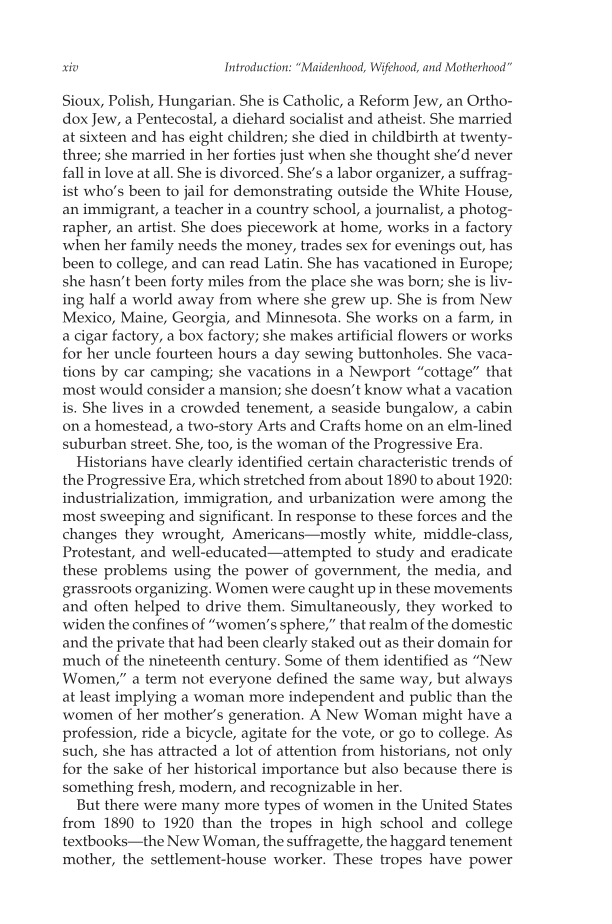xiv Introduction: “Maidenhood, Wifehood, and Motherhood” Sioux, Polish, Hungarian. She is Catholic, a Reform Jew, an Ortho- dox Jew, a Pentecostal, a diehard socialist and atheist. She married at sixteen and has eight children she died in childbirth at twenty- three she married in her forties just when she thought she’d never fall in love at all. She is divorced. She’s a labor organizer, a suffrag- ist who’s been to jail for demonstrating outside the White House, an immigrant, a teacher in a country school, a journalist, a photog- rapher, an artist. She does piecework at home, works in a factory when her family needs the money, trades sex for evenings out, has been to college, and can read Latin. She has vacationed in Europe she hasn’t been forty miles from the place she was born she is liv- ing half a world away from where she grew up. She is from New Mexico, Maine, Georgia, and Minnesota. She works on a farm, in a cigar factory, a box factory she makes artificial flowers or works for her uncle fourteen hours a day sewing buttonholes. She vaca- tions by car camping she vacations in a Newport “cottage” that most would consider a mansion she doesn’t know what a vacation is. She lives in a crowded tenement, a seaside bungalow, a cabin on a homestead, a two-story Arts and Crafts home on an elm-lined suburban street. She, too, is the woman of the Progressive Era. Historians have clearly identified certain characteristic trends of the Progressive Era, which stretched from about 1890 to about 1920: industrialization, immigration, and urbanization were among the most sweeping and significant. In response to these forces and the changes they wrought, Americans—mostly white, middle-class, Protestant, and well-educated—attempted to study and eradicate these problems using the power of government, the media, and grassroots organizing. Women were caught up in these movements and often helped to drive them. Simultaneously, they worked to widen the confines of “women’s sphere,” that realm of the domestic and the private that had been clearly staked out as their domain for much of the nineteenth century. Some of them identified as “New Women,” a term not everyone defined the same way, but always at least implying a woman more independent and public than the women of her mother’s generation. A New Woman might have a profession, ride a bicycle, agitate for the vote, or go to college. As such, she has attracted a lot of attention from historians, not only for the sake of her historical importance but also because there is something fresh, modern, and recognizable in her. But there were many more types of women in the United States from 1890 to 1920 than the tropes in high school and college textbooks—the New Woman, the suffragette, the haggard tenement mother, the settlement-house worker. These tropes have power
Document Details My Account Print multiple pages
Print
You have printed 0 times in the last 24 hours.
Your print count will reset on at .
You may print 0 more time(s) before then.
You may print a maximum of 0 pages at a time.
























































































































































































































































































































































































































































































